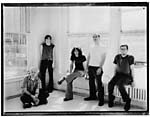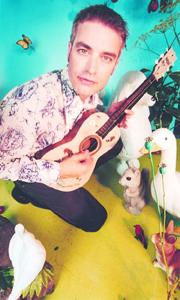IT’S A FOREGONE conclusion that rock isn’t fashionable anymore, that the one-time privileges of band membership—the free beer, the adoring girls or guys, the travel—now resemble something close to a sacrifice. Yes, even the promise of a career in software development is enough to deter many would-be guitarists from hopping in the van with a few friends for a fast-food, empty-club tour of the West Coast. Yet some bands persist, even as the pressures of adulthood loom.
Red Stars Theory
The Hub at University of Washington Friday, November 19
Red Stars Theory contends not only with such pressures but with the unwieldy schedules of its members as well. It’s hard to get the Seattle band’s five musicians in a room together even though they’ve recently released their second album, Life in a Bubble Can Be Beautiful, on a label, Touch and Go, that most bands would give their drummer’s left arm to be on. RST hasn’t even played a show in its hometown since April, so it’s almost shocking when four of the members pile into a snug booth at Hattie’s in Ballard for a chat.
“The whole time we’ve been a band, it’s been sporadic,” says affable singer-guitarist James Bertram. “Once all this started happening and we were on Touch and Go, we were gonna do all this stuff, but then it didn’t work out.”
Drummer Jeremiah Green got sidetracked when his other band, Modest Mouse, signed to Epic and began recording its major-label debut (now in the mixing process, which is why Green’s the only Red Stars Theory member not present at Hattie’s). Bertram’s been otherwise occupied as well; he signed on as bassist for the comparably more active 764-HERO last year. Violinist Seth Warren—yes, they have a violinist—joined the start-up Bugs in Amber, a seven-piece chamber-pop band that is finishing a record of its own. The other two RSTers, bassist Jason Talley and guitarist-vocalist Tonie Palmasani, ruefully admit that this is their main gig, for better or worse.
Though their self-promotional skills are off, these musicians’ attention to detail shines both on record and on the occasions when they’re all on the same stage. The 1997 debut When Sleep Came Slowly established Red Stars Theory as one of Seattle’s best bands, despite few nonmusicians in town knowing about them. They’d come together when Bertram, fresh from the break-up of the noisy and toothsome Lync, began jamming with longtime friends and musical compatriots Green, Palmasani, and Talley. (The three had played together since their teens, when they formed the core of a punk band called Peeved, which Talley describes as a “wannabe straightedge band.”)
RED STARS THEORY’S rolling, epiphany-hugging songs didn’t fit any trend or prevailing sound, and just as the rock-based tunes teetered between quiet swells and foreboding outbursts, the band itself waned as an entity. Their shows became so infrequent, Bertram recalls, that those who did know of the group assumed it’d quietly disbanded. “There were a lot of times people thought we’d broken up,” he says with a laugh.
Nevertheless, RST did manage to tour after recording the first album. Playing for crowds in other cities brought a modicum of attention, which eventually led to the deal with Touch and Go, and to the recording of Life in a Bubble.
With such a reputable label behind them, the band decided to devote more time to the project, settling in with producer Kip Beelman at a couple of Seattle studios. But their rapport and energy took over quickly, and the songs flowed out of them almost before they’d set up the microphones.
“I couldn’t make the first day,” Warren says, “so I came in the second day and they had already recorded four songs.”
The memory triggers a smile in Bertram. “This recording was the coolest, most smoothly done thing from start to finish,” he says.
The result hardly sounds rushed. It opens with the stormy, tension-heightening “How Did This Room Get So White,” a Dirty Three-like rambler with reverbed violin spilling over syncopated drumbeats. The rest of the album isn’t as boisterous as one might have anticipated; the band sounds focused, whether in crafting baleful yet beautiful near-ballads or more insistent, almost mathematical tracks.
As with most inspired art, the creators of it have a hard time figuring out exactly how it came about. Bertram insists that the band willfully stressed its quieter, more reflective side, while Warren says the band’s music shifts unconsciously. They say that producer Beelman called RST “a band that has moments.”
Bertram concurs. “A lot of what ended up on the record we just ‘did,’ and that’s how it came out,” he says. “It may have never been like that before and may never be like that again.” It’s a haphazard attitude, but for Red Stars Theory, haphazard works just fine.






